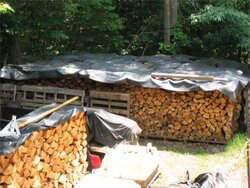I have about six cords of freshly split wood (and more getting split every weekend I can). The wood was cut in early July of this year. I have stacked the wood relatively tight - not in the long island fashion. It is stacked on pallets on top of a concrete paddock under quite abit of deciduous cover - the best I can do at this point. The wood gets part sun about half the day, and some wind, but not alot. Most of the wood is red oak, with some white oak and hickory.
My question is the topic title - to cover or not to cover (with poly tarp)? The wood is currently covered, and I expect the wood to season for two years. During this time, should I leave it covered or not. A friend of mine who burns alot of wood says that I should leave the piles uncovered.
I am not covering and uncovering as we get rain - just don't have the inclination to do so. So, any advice from our community here would be very welcome.
My question is the topic title - to cover or not to cover (with poly tarp)? The wood is currently covered, and I expect the wood to season for two years. During this time, should I leave it covered or not. A friend of mine who burns alot of wood says that I should leave the piles uncovered.
I am not covering and uncovering as we get rain - just don't have the inclination to do so. So, any advice from our community here would be very welcome.


